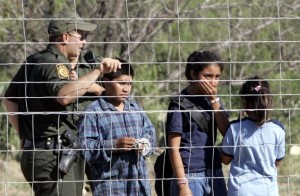The $3.7 billion Band-Aid for the border

IMMIGRATION CRISIS: Border officials have been overwhelmed by the number of immigrants crossing into the U.S.
By Rob Nikolewski │ New Mexico Watchdog
When you study economics, one of the first things you learn is that people respond to incentives.
And that maxim goes a long way toward explaining the crisis on our southern border that has led to the impromptu establishment of facilities across the country to house the flood of migrants from Central America coming into the United States, including the Federal Law Enforcement Training Center in Artesia, N.M.
The situation has been called a humanitarian crisis but it’s also an economic crisis. After all, it’s not rich El Salvadorans or Hondurans but impoverished Central Americans who are making the dangerous trip through Mexico and into the U.S.
Some are escaping the drug and gang violence in their countries, some are looking for a better standard of living and many are looking for both.
So the incentive to leave their countries is strong and, given the fact that over the years millions who entered the U.S. illegally have been able to stay, the incentive to make the United States their final destination is powerful.
And, ironically, if the political leaders in Washington ever pass an immigration bill that includes tighter border security measures, that only heightens the incentive to make the journey now before getting into the U.S. gets more difficult.
President Obama has called for $3.7 billion to help handle the crisis in the short term. According to reports, more than half of that is going to handling resettling chores.
Conservatives who want to buckle up the border complain about that — and they’ve got a point about the cost to taxpayers — but it’s a law passed in 2008 under former President George W. Bush that prevents the government from immediately returning young migrants to their respective countries.
Only children entering illegally from countries contiguous to the U.S — Canada and Mexico — can be sent back immediately.
When it was passed, the law was intended to address human trafficking instead of the crisis at hand, but that’s the law on the books now.
Furthermore, the 2008 law requires the government to make the best effort possible to reunite unaccompanied minors with a parent or guardian and give them a hearing date.
But the courts are backlogged and — speaking about incentives again — why show up for a court date when you risk getting sent back?
A similar situation may play out at the FLETC facility in Artesia, as New Mexico Department of Public Safety Secretary Greg Fouratt recently pointed out.
“I worry about people who have taken this remarkable step in their life that has to be borne out of desperation, to come to the United States, and then they learn that they’re going back to the place that they left, they might not have the motivation to stick around,” Fouratt told me.
Some say that the U.S. should take in this wave of immigrants but it begs the question, how many more can the country absorb? And, despite the desperate circumstances that inspired many of them, don’t laws need to be respected?
Even House Democratic Minority Whip Steny Hoyer said this week, “The United States cannot be expected to give sanctuary to every child in the world that is exposed to danger in their country because of the failure of the country’s government, or the local municipality’s government, to assist in keeping their own children safe.”
But in order to do that, it takes border enforcement first and foremost. Without it, expect more $3.7 billion payments to come.
“When a parent or relative in those countries just paid … up to $7,000 to smugglers to take that child into the country,” said Republican Sen. Jeff Flake of Arizona, who supported the Senate immigration bill that stalled in the House, “when they see those planeloads of kids coming back, then it will stop.”
It’s a hard truth, but he’s right.
Contact Rob Nikolewski at rnikolewski@watchdog.org and follow him on Twitter @robnikolewski







